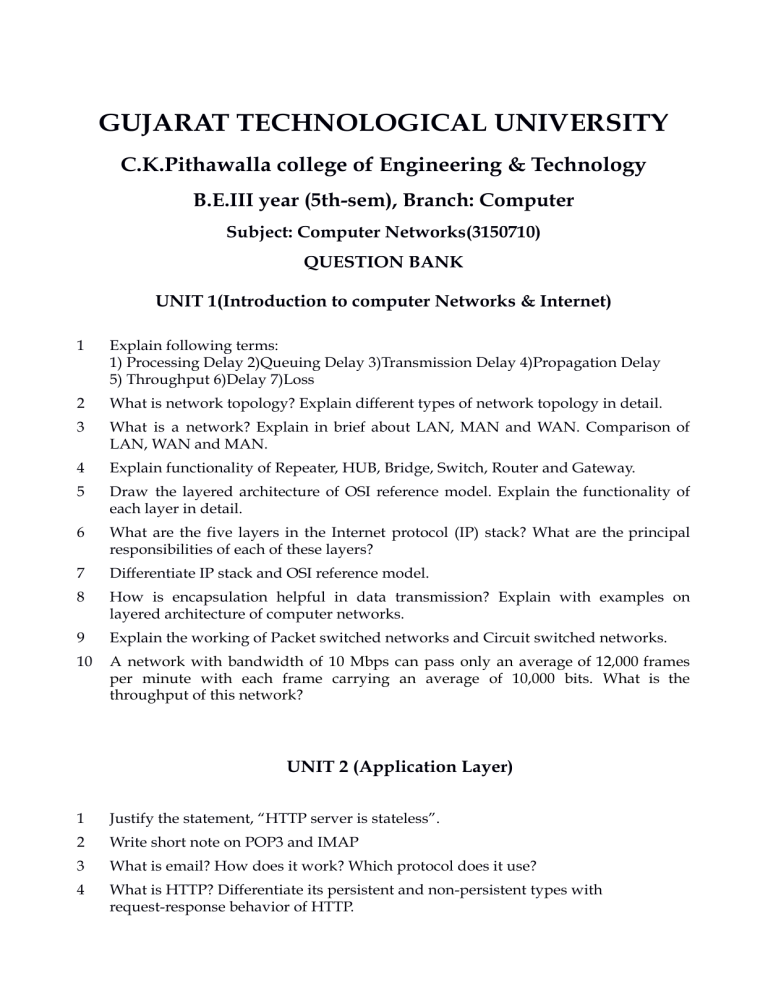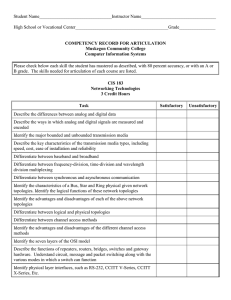
GUJARAT TECHNOLOGICAL UNIVERSITY C.K.Pithawalla college of Engineering & Technology B.E.III year (5th-sem), Branch: Computer Subject: Computer Networks(3150710) QUESTION BANK UNIT 1(Introduction to computer Networks & Internet) 1 Explain following terms: 1) Processing Delay 2)Queuing Delay 3)Transmission Delay 4)Propagation Delay 5) Throughput 6)Delay 7)Loss 2 What is network topology? Explain different types of network topology in detail. 3 What is a network? Explain in brief about LAN, MAN and WAN. Comparison of LAN, WAN and MAN. 4 Explain functionality of Repeater, HUB, Bridge, Switch, Router and Gateway. 5 Draw the layered architecture of OSI reference model. Explain the functionality of each layer in detail. 6 What are the five layers in the Internet protocol (IP) stack? What are the principal responsibilities of each of these layers? 7 Differentiate IP stack and OSI reference model. 8 How is encapsulation helpful in data transmission? Explain with examples on layered architecture of computer networks. 9 Explain the working of Packet switched networks and Circuit switched networks. 10 A network with bandwidth of 10 Mbps can pass only an average of 12,000 frames per minute with each frame carrying an average of 10,000 bits. What is the throughput of this network? UNIT 2 (Application Layer) 1 Justify the statement, “HTTP server is stateless”. 2 Write short note on POP3 and IMAP 3 What is email? How does it work? Which protocol does it use? 4 What is HTTP? Differentiate its persistent and non-persistent types with request-response behavior of HTTP. 5 Explain the concept of Cookies and its components with suitable examples. Consider the following HTTP message and answer the following questions: i. From which browser URL is requested? ii. Does the browser request a non-persistent or a persistent connection? iii. Which is the (complete) URL of the document requested by the user? iv. Which HTML method is used to retrieve the requested URL? 7 Explain HTTP GET and HTTP POST method in detail. 8 What is a proxy server? What are the benefits of caching proxy servers? 9 Why distributed database design is more preferred over centralized design to implement DNS on the Internet? Justify. Also explain the way of DNS servers to handle the recursive DNS query using a suitable diagram. 10 Write a short note on Domain Name System (DNS). UNIT 3 (Transport Layer) 1. 2. 3. 4. 5. 6. 7. 8. 9. Discuss transport layer multiplexing and demultiplexing Explain in brief the socket. Difference between Connection oriented vs Connection less service Discuss the principles of reliable data transfer. Discuss the working principle of UDP. Explain Transmission Control Protocol with TCP header fields. List and explain the TCP services provided by the transport layer. Describe TCP segment structure and justify the importance of its field values. Explain connection establishment and connection release in transport layer protocols. 10. Explain TCP connection establishment and connection release in transport layer protocols. 11. What is the congestion? List the approaches of congestion control. 12. Difference between flow control and congestion control. 13. Explain the UDP checksum mechanism for error detection with examples. UNIT 4 (Network Layer) 1. 2. 3. 4. 5. Define Unicasting, Multicasting and Broadcasting. Discuss various design issues of the Network layer. Explain connectionless service of the network layer. Differentiate between Virtual circuit subnet v/s Datagram subnet. What is the main difference between forwarding and routing? Explain at least two forwarding techniques used by the router to switch packets from input port to output port of the router. 6. Differentiate broadcast and multicast with their functionalities. 7. Explain Packet Fragmentation with an example. 8. Explain IPv4 datagram format and importance of each field. 9. What is a routing algorithm? List major types of it. 10. What is an IP address? What is Subnet? Explain different IP address Classes.







